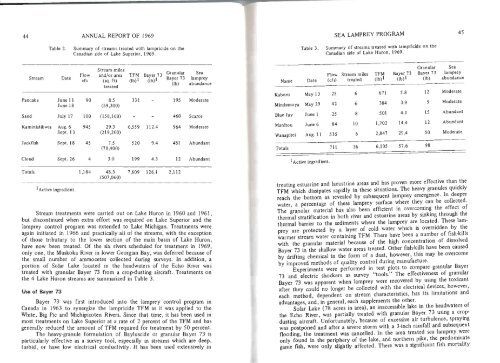Create successful ePaper yourself
Turn your PDF publications into a flip-book with our unique Google optimized e-Paper software.
44<br />
ANNUAL REPORT OF <strong>1969</strong><br />
SEA LAMPREY PROGRAM<br />
45<br />
Table 2.<br />
Summary of streams treated with lampricide on the<br />
Canadian side of Lake Superior, <strong>1969</strong>.<br />
Table 3.<br />
Summary of streams treated with lampricide on the<br />
Canadian side of Lake Huron, <strong>1969</strong>.<br />
Stream miles<br />
Bayer 73 Granular Sea<br />
Flow and/or area TFM<br />
Stream Date (Ib)l Bayer 73 lamprey<br />
cfs (sq. ft) (Ib) 1<br />
(Ib) abundance<br />
treated<br />
Pancake June 11 90 8.5 331 - 195 Moderate<br />
June 18 (59,300)<br />
Sand July 17 100 (158,160) - - 460 Scarce<br />
Kaministikwia Aug. 6 945 29.3 6,559 112.4 964 Moderate<br />
Sept. 13 (219,200)<br />
Jackfish Sept. 18 45 7.5 520 9.4 481 Abundant<br />
(70,400)<br />
Cloud Sept. 26 4 3.0 199 4.3 12 Abundant<br />
Totals 1,184 48.3 7,609 126.1 2,112<br />
(507,060)<br />
1Active ingredient.<br />
Stream treatments were carried out on Lake Huron in 1960 and 1961,<br />
but discontinued when extra effort was required on Lake Superior and the<br />
lamprey control program was extended to Lake Michigan. Treatments were<br />
again initiated in 1966 and practically all of the streams, with the exception<br />
of those tributary to the lower section of the main basin of Lake Huron,<br />
have now been treated. Of the six rivers scheduled for treatment in <strong>1969</strong>,<br />
only one, the Muskoka River in lower Georgian Bay, was deferred because of<br />
the small number of ammocetes collected during surveys. In addition, a<br />
portion of Solar Lake located in the headwaters of the Echo River was<br />
treated with granular Bayer 73 from a crop-dusting aircraft. Treatments on<br />
the 4 Lake Huron streams are summarized in Table 3.<br />
Use of Bayer 73<br />
Bayer 73 was first introduced into the lamprey control program in<br />
Canada in 1963 to synergize the lampricide TFM as it was applied to the<br />
White, Big Pic and Michipicoten Rivers. Since that time, it has been used in<br />
most treatments on Lake Superior at a rate of 2 percent of the TFM and has<br />
generally reduced the amount of TFM required for treatment by 50 percent.<br />
The heavy-granule formulation of Bayluscide or granular Bayer 73 is<br />
particularly effective as a survey tool, especially in streams which are deep,<br />
turbid, or have low electrical conductivity. It has been used extensively in<br />
Name<br />
Date<br />
Flow<br />
(efs)<br />
Stream miles<br />
treated<br />
TFM<br />
(Ib) 1<br />
Bayer 73<br />
(Ib)l<br />
Granular<br />
Bayer 73<br />
(Ib)<br />
Sea<br />
lamprey<br />
abundance<br />
Kaboni May 13 25 6 671 5.8 12 Moderate<br />
Mindemoya May 29 42 6 384 3.9 9 Moderate<br />
Blue Jay June 1 25 8 501 4.1 15 Abundant<br />
Manitou June 6 84 10 1,702 14.4 12 Abundant<br />
Wanapitei Aug. 11 535 6 2,847 2S' .4 50 Moderate<br />
Totals 711 36 6,105 57.6 98<br />
--<br />
I Active ingredient.<br />
treating estuarine and lacustrine areas and has proven more effective than the<br />
TFM which dissipates rapidly in these situations. The heavy granules quickly<br />
reach the bottom as revealed by subsequent lamprey emergence. In deeper<br />
water, a percentage of these lamprey surface where they can be collected.<br />
The granular material has also been efficient in overcoming the effect of<br />
thermal stratification in both river and estuarine areas by sinking through the<br />
thermal barrier to the sediments where the lamprey are located. These lamprey<br />
are protected by a layer of cold water which is overridden by the<br />
warmer stream water containing TFM. There have been a number of fish-kills<br />
with the granular material because of the high concentration of dissolved<br />
Bayer 73 in the shallow water areas treated. Other fish-kills have been caused<br />
by drifting chemical in the form of a dust, however, this may be overcome<br />
by improved methods of quality control during manufacture.<br />
Experiments were performed in test plots to compare granular Bayer<br />
73 and electric shockers as survey "tools." The effectiveness of granular<br />
Bayer 73 was apparent when lamprey were recovered by using the toxicant<br />
after they could no longer be collected with the electrical devices, however,<br />
each method, dependent on stream characteristics, has its limitations and<br />
advantages, and, in general, each supplements the other.<br />
Solar Lake (78 acres in area), an inaccessible lake in the headwaters of<br />
the Echo River, was partially treated with granular Bayer 73 using a cropdusting<br />
aircraft. Unfortunately, because of excessive air turbulence, spraying<br />
was postponed and after a severe storm with a 3-inch rainfall and subsequent<br />
flooding, the treatment was cancelled. In the area treated sea lamprey were<br />
only found in the periphery of the lake, and northern pike, the predominate<br />
game fish, were only slightly affected. There was a significant fish mortality
















